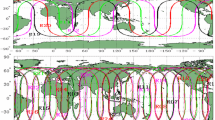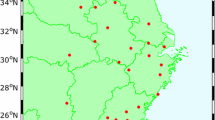Abstract
A key limitation of precise point positioning (PPP) is the long convergence time, which requires about 30 min under normal conditions. Frequent cycle slips or data gaps in real-time operation force repeated re-convergence. Repairing cycle slips with GPS data alone in severely blocked environments is difficult. Adding GLONASS data can supply redundant observations, but adds the difficulty of having to deal with differing wavelengths. We propose a single-difference between epoch (SDBE) method to integrate GPS and GLONASS for cycle slip fixing. The inter-system bias can be eliminated by SDBE, thus only one receiver clock parameter is needed for both systems. The inter-frequency bias of GLONASS satellites also cancels in the SDBE, so cycle slips are preserved as integers, and the LAMBDA method is adopted to search for cycle slips. Data from 7 days of 20 globally distributed IGS sites were selected to test the proposed cycle slip fixing procedure with artificial blocking of the signal; cycle slips were introduced for all un-blocked satellites at each epoch. For a 30-s sampling interval, the average success rate of fixing can be improved from 73 to 98 % by adding GLONASS. Even for a 180-s sampling interval, GPS + GLONASS can achieve a success rate of 81 %. A real-time kinematic PPP experiment was also performed, and the results show that using GPS + GLONASS can achieve continuous high-accuracy real-time PPP without re-convergence.











Similar content being viewed by others
References
Al-Shaery A, Zhang S, Rizos C (2013) An enhanced calibration method of GLONASS inter-channel bias for GNSS RTK. GPS Solut 17(2):165–173
Banville S, Langley R (2009) Improving realtime kinematic PPP with instantaneous cycle slip correction. In: Proceedings of ION GNSS 2009, Sept 16–19, GA, pp 2470–2478
Bastos L, Landau H (1988) Fixing cycle slips in dual-frequency kinematic GPS-applications using Kalman filtering. Manuscr Geod 13(4):249–256
Bisnath SB, Langley RB (2000) Automated cycle-slip correction of dual-frequency kinematic GPS data. In: Proceedings of 47th conference of CASI, Ottawa
Blewitt G (1990) An automatic editing algorithm for GPS data. Geophys Res Lett 17:199–202
Cai C, Gao Y (2008) Estimation of GPS/GLONASS system time difference with application to PPP. In: Proceedings of ION GNSS 2008, Institute of navigation, Sept 16–19, Savannah, pp 2880–2887
Carcanague S (2012) Real-time geometry-based cycle slip resolution technique for single-frequency PPP and RTK. In: Proceedings of ION GNSS 2012, Institute of Navigation, Sept 17–21, Nashville, pp 1136–1148
Chuang S, Wenting Y, Weiwei S, Yidong L, Rui Z (2013) GLONASS pseudorange inter-channel biases and their effects on combined GPS/GLONASS precise point positioning. GPS solut 17(4):439–451
Colombo OL, Bhapkar UV, Evans AG (1999) Inertial-aided cycle-slip detection/correction for precise, long-baseline kinematic GPS. In: Proceedings of ION GPS-99, Sept 14–17, Nashville, pp 1915–1922
Dai L, Wang J, Rizos C, Han S (2003) Predicting atmospheric biases for real-time ambiguity resolution in GPS/GLONASS reference station networks. J Geod 76(11–12):617–628
Gao Y, Li Z (1999) Cycle slip detection and ambiguity resolution algorithms for dual-frequency GPS data processing. Mar Geod 22(4):169–181
Geng J, Meng X, Dodson A, Ge M, Teferl F (2010) Rapid re-convergences to ambiguity-fixed solutions in precise point positioning. J Geod 84(12):705–714
Gregorius TLH, Blewitt G (1999) Modeling weather fronts to improve GPS heights: a new tool for GPS meteorology? J Geophys Res 104(B7):15261–15279
Gu S, Shi C, Lou Y, Feng Y, Ge M (2013) Generalized-positioning for mixed-frequency of mixed-GNSS and its preliminary applications. In: China satellite navigation conference (CSNC) 2013 proceedings, pp 399–428
Han S (1997) Quality-control issues relating to instantaneous ambiguity resolution for real-time GPS kinematic positioning. J Geod 71(6):351–361
Hatch R (1982) The synergism of GPS code and carrier measurements. In: Proceedings of the third international symposium on satellite Doppler positioning at Physical Sciences Laboratory of New Mexico State University, Feb 8–12, vol 2, pp 1213–1231
Kim D, Langley RB (2001) Instantaneous real-time cycle-slip correction of dual frequency GPS data. In: Proceedings of the international symposium on kinematic systems in geodesy, geomatics and navigation, Banff, 5–8 June, pp 255–264
Kouba J, Héroux P (2001) Precise point positioning using IGS orbit and clock products. GPS Solut 5(2):12–28
Lee HK, Wang J, Rizos C (2003) Effective cycle slip detection and identification for high precision GPS/INS integrated systems. J Navig 56(3):475–486
Li P, Zhang X (2013) Integrating GPS and GLONASS to accelerate convergence and initialization times of precise point positioning. GPS Solut 18(3):461–471
Melbourne WG (1985) The case for ranging in GPS-based geodetic systems. In: Proceedings of the first international symposium on precise positioning with the global positioning system, Rockville, pp 15–19
Shan S, Bevis M, Kendrick E, Mader GL, Raleigh D, Hudnut K, Sartori M, Phillips D (2007) Kinematic GPS solutions for aircraft trajectories: identifying and minimizing systematic height errors associated with atmospheric propagation delays. Geophys Res Lett 34:L23S07. doi:10.1029/2007GL030889
Shi C, Gu S, Lou Y, Ge M (2012) An improved approach to model ionospheric delays for single-frequency precise point positioning. Adv Space Res 49(12):1698–1708
Teunissen PJG (1995) The least squares ambiguity decorrelation adjustment: a method for fast GPS integer estimation. J Geod 70:65–82
Wang J, Rizos C, Stewart MP, Leick A (2001) GPS and GLONASS integration: modeling and ambiguity resolution issues. GPS Solut 5(1):55–64
Wanninger L (2012) Carrier phase inter-frequency biases of GLONASS receivers. J Geod 86(2):139–148
Wu J, Wu S, Hajj G, Bertiger W, Lichten S (1993) Effects of antenna orientation on GPS carrier phase. Manuscr Geod 18(2):91–98
Wübbena G (1985) Software developments for geodetic positioning with GPS using TI-4100 code and carrier measurements. In: Proceedings of the first international symposium on precise positioning with the global positioning system, Rockville
Xu G (2007) GPS: theory, algorithms and applications, 2nd edn. Springer, Berlin
Yamada H, Takasu T, Kubo N, Yasuda A (2010) Evaluation and calibration of receiver inter-channel biases for RTK-GPS/GLONASS. In: Proceedings of ION GNSS-2010, Portland, Oregon, Sept 21–24, pp 1580–1587
Yao Y, Zhang R, Song W, Shi C, Lou Y (2013) An improved approach to model regional ionosphere and accelerate convergence for precise point positioning. Adv Space Res 52(8):1406–1415
Zhang X, Li X (2012) Instantaneous re-initialization in real-time kinematic PPP with cycle slip fixing. GPS Solut 16(3):315–327
Zumberge JF, Heflin MB, Jefferson DC, Watkins MM, Webb FH (1997) Precise point positioning for the efficient and robust analysis of GPS data from large networks. J Geophys Res 102(B3):5005–5017
Acknowledgments
This study is based on an improved Positioning and Navigation Data Analyst (PANDA) software package which was originally developed by Wuhan University. This work is supported by National 973 Program of China (No. 2012CB957701), National Natural Science Foundation of China (Nos. 41074008, 41374034, 41404010, 41104024), Research Fund for the Doctoral Program of Higher Education of China (No. 20120141110025), Non-profit Industry Financial Program of MWR (No. 201401072). The authors thank the IGS, EPN, and the ESA IGS analysis center for providing the data and products. The thanks also go to Professor Xiaoji Niu and Ph.D student Yahao Chen for Net-RTK data processing. Finally, the authors are also very grateful for the comments and remarks of the reviewers and the chief editor, which helped to significantly improve the manuscript.
Author information
Authors and Affiliations
Corresponding author
Rights and permissions
About this article
Cite this article
Ye, S., Liu, Y., Song, W. et al. A cycle slip fixing method with GPS + GLONASS observations in real-time kinematic PPP. GPS Solut 20, 101–110 (2016). https://doi.org/10.1007/s10291-015-0439-3
Received:
Accepted:
Published:
Issue Date:
DOI: https://doi.org/10.1007/s10291-015-0439-3




